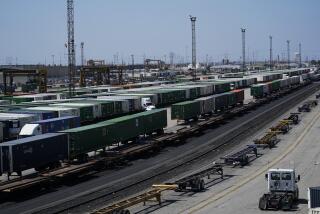EPA limits mercury and other pollutants from cement plants
- Share via
The Environmental Protection Agency on Monday completed regulations limiting the release of mercury and other toxic air pollutants from cement plants, a move the Obama administration said would save lives but that cement makers warned could drive jobs overseas.
This is the first time the federal government has restricted emissions from existing cement kilns. The regulations aim to reduce, by 2013, the annual emissions of mercury and particulate matter by 92%, hydrochloric acid by 97% and sulfur dioxide by 78%.
EPA officials said the limits would benefit children, whose brains can be damaged by mercury that makes its way through the air to water and then to fish that children eat. They also predicted the rules would stave off thousands of premature heart and lung deaths each year attributed to particulate pollution.
“By reducing harmful pollutants in the air we breathe, we cut the risk of asthma attacks and save lives,” EPA Administrator Lisa P. Jackson said in a statement.
Environmentalists said California, which is the nation’s largest producer of cement and has several heavy-emitting kilns, would see particularly high public health returns.
“From the Bay Area to San Bernardino, Californians are going to have cleaner, healthier air thanks to the EPA’s new rule,” said James S. Pew, a staff attorney for the environmental group Earthjustice.
Cement producers said the rules would cost them “several billion dollars” to implement by installing pollution scrubbers at existing kilns. They warned that regulations could lead to plant closures and job outsourcing.
“More cement will need to be imported to make up for shrinking domestic supply,” said Brian McCarthy, chief executive and president of the Skokie, Ill.-based Portland Cement Assn. “We fear this could constrain the U.S. government’s efforts to stimulate the economy, create jobs and rehabilitate the nation’s infrastructure.”
EPA analysts estimate the rules will trigger $926 million to $950 million in annual compliance costs nationwide in 2013, while yielding $6.7 billion to $18 billion in benefits for public health and the environment.
Cement industry officials waged an intense yearlong lobbying campaign against the regulations, which the EPA first proposed in 2009. The final rules slightly increase mercury limits, but EPA officials said the overall emissions limits did not “appreciably change” from what they first proposed.
Environmental groups noted the changes but said they remained pleased with EPA’s final product.
“We still think this is a very strong rule,” said Avinash Kar, a staff attorney with the Natural Resources Defense Council in San Francisco.
jtankersley@tribune.com
More to Read
Sign up for Essential California
The most important California stories and recommendations in your inbox every morning.
You may occasionally receive promotional content from the Los Angeles Times.










